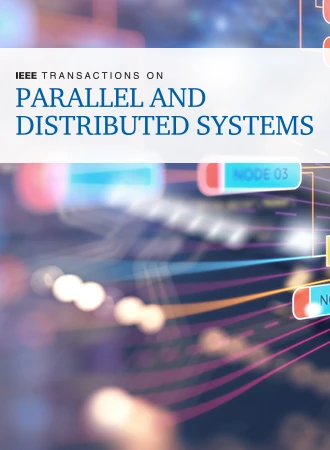利用分割实时迁移实现位置保护图遍历
IF 5.6
2区 计算机科学
Q1 COMPUTER SCIENCE, THEORY & METHODS
IEEE Transactions on Parallel and Distributed Systems
Pub Date : 2024-08-02
DOI:10.1109/TPDS.2024.3436828
引用次数: 0
摘要
图是许多现实世界数据的模型,如社会、交通、生物和通信数据。因此,图遍历(包括多跳或图行走查询)一直是图存储的关键操作。然而,由于不同的图遍历可能会触及不同的顶点集,因此很难甚至不可能有一种放之四海而皆准的图分区算法,能为各种图遍历工作负载保留访问局部性。与此同时,之前基于分片的迁移也面临着两难选择,粗粒度迁移可能会带来更多迁移开销,而不是更多的本地性优势,而细粒度迁移通常需要过多的元数据,并产生非同小可的维护成本。我们提出了 Pragh,这是一种针对键值对形式图存储的高效本地性保护实时图迁移方案。Pragh 的关键理念是一种拆分迁移模型,只对值进行物理迁移,而将键保留在初始位置。这样既能实现细粒度迁移,又能避免维护过多的元数据。Pragh 整合了来自 DrTM-KV 的 RDMA 友好位置缓存,为迁移数据提供完全本地化的访问,并进一步对缓存替换策略进行了新颖的重用,以实现轻量级监控。Pragh 还通过检查和转发机制进一步支持演化图,以解决图数据更新和迁移之间的冲突。在一个支持 RDMA 的 8 节点集群(100 Gbps)上使用具有代表性的图形遍历基准进行的评估表明,Pragh 可将吞吐量提高 19 倍,将中位延迟降低 94%,这要归功于可消除 97% 远程访问的拆分实时迁移。在 LUBM-10240 等代表性工作负载上,由于减少了 88% 的远程访问,将拆分实时迁移移植到 "悟空 "后,吞吐量最多提高了 2.53 倍。这进一步证实了 Pragh 的有效性和通用性。最后,虽然 Pragh 专注于基于 RDMA 的图遍历,但我们通过扩展它来支持传统网络下的图遍历,从而展示了它的通用性。在使用 10 Gbps TCP/IP 网络的同一集群上对图遍历基准和图查询工作负载进行的评估进一步证实了 Pragh 在不使用 RDMA 的情况下的有效性。具体而言,在 LUBM-10240 上进行评估时,使用 Pragh 的 Wukong-TCP 可实现高达 1.87 倍的吞吐量改进,远程访问量减少了 56%。本文章由计算机程序翻译,如有差异,请以英文原文为准。
Locality-Preserving Graph Traversal With Split Live Migration
Graph models many real-world data like social, transportation, biology, and communication data. Hence, graph traversal including multi-hop or graph-walking queries has been the key operation atop graph stores. However, since different graph traversals may touch different sets of vertices, it is hard or even impossible to have a one-size-fits-all graph partitioning algorithm that preserves access locality for various graph traversal workloads. Meanwhile, prior shard-based migration faces a dilemma such that coarse-grained migration may incur more migration overhead over increased locality benefits, while fine-grained migration usually requires excessive metadata and incurs non-trivial maintenance costs. We present Pragh, an efficient locality-preserving live graph migration scheme for graph stores in the form of key-value pairs. The key idea of Pragh is a split migration model that only migrates values physically while retaining keys in the initial location. This allows fine-grained migration while avoiding the need to maintain excessive metadata. Pragh integrates an RDMA-friendly location cache from DrTM-KV to provide fully-localized access to migrated data and further makes a novel reuse of the cache replacement policy for lightweight monitoring. Pragh further supports evolving graphs through a check-and-forward mechanism to resolve the conflict between updates and migration of graph data. Evaluations on an 8-node RDMA-capable cluster (100 Gbps) using a representative graph traversal benchmark show that Pragh can increase the throughput by up to 19× and decrease the median latency by up to 94%, thanks to split live migration that eliminates 97% remote accesses. A port of split live migration to Wukong shows up to 2.53× throughput improvement on representative workloads like LUBM-10240, thanks to a reduction of 88% remote accesses. This further confirms the effectiveness and generality of Pragh. Finally, though Pragh focuses on RDMA-based graph traversal, we show its generality by extending it to support graph traversals under traditional networking. Evaluations on the graph traversal benchmarks and graph query workloads on the same cluster but with 10 Gbps TCP/IP network further confirm its effectiveness without RDMA. Specifically, when evaluating on the LUBM-10240, Wukong-TCP with Pragh can achieve up to 1.87× throughput improvement with a 56% decrease in remote accesses.
求助全文
通过发布文献求助,成功后即可免费获取论文全文。
去求助
来源期刊

IEEE Transactions on Parallel and Distributed Systems
工程技术-工程:电子与电气
CiteScore
11.00
自引率
9.40%
发文量
281
审稿时长
5.6 months
期刊介绍:
IEEE Transactions on Parallel and Distributed Systems (TPDS) is published monthly. It publishes a range of papers, comments on previously published papers, and survey articles that deal with the parallel and distributed systems research areas of current importance to our readers. Particular areas of interest include, but are not limited to:
a) Parallel and distributed algorithms, focusing on topics such as: models of computation; numerical, combinatorial, and data-intensive parallel algorithms, scalability of algorithms and data structures for parallel and distributed systems, communication and synchronization protocols, network algorithms, scheduling, and load balancing.
b) Applications of parallel and distributed computing, including computational and data-enabled science and engineering, big data applications, parallel crowd sourcing, large-scale social network analysis, management of big data, cloud and grid computing, scientific and biomedical applications, mobile computing, and cyber-physical systems.
c) Parallel and distributed architectures, including architectures for instruction-level and thread-level parallelism; design, analysis, implementation, fault resilience and performance measurements of multiple-processor systems; multicore processors, heterogeneous many-core systems; petascale and exascale systems designs; novel big data architectures; special purpose architectures, including graphics processors, signal processors, network processors, media accelerators, and other special purpose processors and accelerators; impact of technology on architecture; network and interconnect architectures; parallel I/O and storage systems; architecture of the memory hierarchy; power-efficient and green computing architectures; dependable architectures; and performance modeling and evaluation.
d) Parallel and distributed software, including parallel and multicore programming languages and compilers, runtime systems, operating systems, Internet computing and web services, resource management including green computing, middleware for grids, clouds, and data centers, libraries, performance modeling and evaluation, parallel programming paradigms, and programming environments and tools.
 求助内容:
求助内容: 应助结果提醒方式:
应助结果提醒方式:


